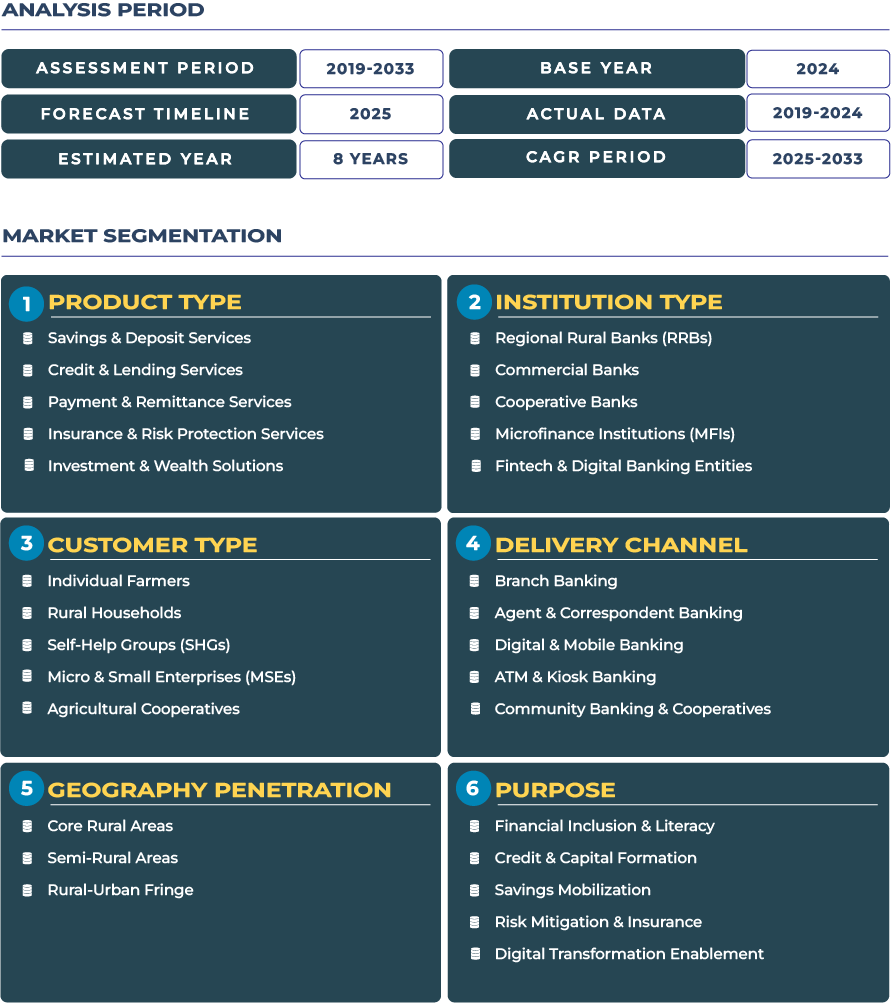Peace-Driven Rural Financial Inclusion: How Colombia’s Post-Conflict Banking Ecosystem is Rebuilding the Countryside
Colombia rural banking market stands at a transformative juncture, where financial inclusion intertwines with post-conflict reconstruction and agricultural renewal. The country’s transition from decades of internal conflict to peacebuilding has not only reshaped its social fabric but also spurred a surge in formal banking participation across the countryside. In 2025, the Colombia rural banking market is valued at USD 10.2 billion and is expected to grow to USD 14.6 billion by 2033, expanding at a steady CAGR of 4.5%. This growth trajectory is underpinned by the rise of traceability finance in coffee exports, the digitalization of rural cooperative systems, and the expansion of inclusive credit and remittance solutions. Rural banking in Colombia is no longer just about access to capital, it is about empowering communities to participate in global agricultural and sustainability networks.
Note:* The market size refers to the total fees/revenue generated by banks through various services.
Colombia Rural Banking Market Outlook: From Post-Conflict Recovery to Traceable Agricultural Finance
The resurgence of the Colombia rural banking industry has been closely tied to its peace-driven economic strategy. Rural banks and cooperatives are focusing on rebuilding trust through transparent lending practices and verified agricultural finance. With coffee, cocoa, and palm oil forming the backbone of rural livelihoods, banks are structuring traceability-linked loans that connect smallholder farmers to global buyers demanding certified and sustainable products. The Banco de la República has promoted rural credit expansion and digital banking channels to strengthen market access, while initiatives from the Ministry of Agriculture and Rural Development continue to incentivize formal banking penetration in regions recovering from conflict. The rural banking sector’s alignment with Colombia’s peace accord objectives has resulted in stronger economic reintegration, improved loan repayment rates, and enhanced trust in cooperative models.
Drivers & Restraints: Cooperative Finance and Digital Expansion Define the Next Rural Frontier
Strong Cooperative Coffee-Financing Tradition Fuels Market Momentum
One of the defining strengths of the Colombia rural banking sector lies in its cooperative-driven credit culture, particularly within the coffee industry. Institutions such as Federación Nacional de Cafeteros have developed specialized financial programs that extend micro-loans, pre-finance contracts, and crop insurance for coffee farmers engaged in certified trade. These models link directly with global markets that prioritize sustainability and traceability, driving the growth of credit and lending services. Furthermore, the growth of fintech-backed cooperative networks has bridged long-standing geographic divides, bringing secure savings and digital payment systems to remote areas through mobile platforms. Such advancements are bolstered by Colombia’s commitment to financial inclusion as outlined in the Superintendencia Financiera de Colombia’s financial literacy programs, which target rural populations and women entrepreneurs.
Security Challenges and Uneven Digital ID Adoption Constrain Broader Inclusion
Despite remarkable progress, several challenges temper the full-scale expansion of Colombia rural banking ecosystem. Persistent security concerns in certain regions continue to deter physical branch expansion, limiting access for dispersed farming communities. Additionally, the uneven rollout of digital identity systems restricts onboarding to mobile financial platforms, thereby slowing the uptake of savings and insurance products. Informal lending remains prevalent in remote zones, exposing smallholders to predatory interest rates and limiting their participation in formal finance. Natural disasters such as floods and landslides in the Andean region further disrupt credit cycles and collateral valuation processes. Addressing these structural issues requires coordinated investment in digital infrastructure, risk mapping, and public-private partnerships that bridge the last mile of rural finance delivery.
Trends & Opportunities: Traceability, Technology, and Blended Finance Shape the Future
Blockchain Traceability and Community Microcredit Define a New Financial Paradigm
A defining trend in the Colombia rural banking landscape is the adoption of blockchain-enabled traceability systems for agricultural exports. These digital platforms, used by rural cooperatives and financial institutions, ensure transparency across the supply chain, from seed to shipment. For example, specialty coffee exporters are now leveraging blockchain finance to unlock better loan terms, as verifiable transaction data enhances creditworthiness. Alongside this, community-based microcredit networks have scaled rapidly, especially in departments like Huila and Nariño, empowering smallholder groups to co-guarantee loans and manage collective savings. The intersection of digital finance and cooperative lending is reducing dependency on intermediaries and ensuring that profits circulate within rural communities.
Opportunities in Traceability-Linked Pre-Finance and Post-Conflict Land Rehabilitation Loans
Significant opportunities are emerging in traceability-linked premium pre-finance and post-conflict land-rehabilitation lending. Financial institutions are designing blended credit lines supported by donor agencies and development banks that incentivize sustainable farming and reforestation projects. For instance, the Bancóldex rural lending program now integrates concessional tranches for post-conflict municipalities to fund productive reintegration projects. These efforts not only expand the rural banking sector but also create pathways for displaced populations to rebuild livelihoods. As Colombia’s agricultural exports increasingly depend on traceable, climate-smart practices, rural banking institutions have a critical opportunity to lead in financing the sustainability transition.
Competitive Landscape: Financial Innovation Anchored in Trust and Traceability
The Colombia rural banking market is becoming increasingly competitive, driven by collaboration between local microfinance institutions and international development partners. Banco Caja Social’s Bancamía, for instance, has deepened outreach in post-conflict areas, focusing on female-led cooperatives and sustainable farming loans. This development signify how traceability finance and blended concessional lending are redefining rural financial services, enhancing both repayment assurance and developmental impact.







